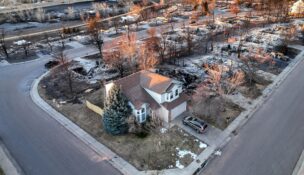Who Owns Colorado: Vail’s winter glow
David Lewis //December 1, 2010//

The sun over Vail today shines on 18 inches of snow, and the Gore Valley’s mountains, chalets, condos, hotels, even its gas stations glow. The whole scene registers as almost absurdly picturesque, like a Thomas Kinkade painting.
A foot-and-a-half is sticking, with more predicted and ski season starting in a couple of weeks. Vail’s economy is starting to glow again, or hum, or whatever it is affluent resorts do.
Early winter snowfall is one reason. The white stuff buoys everyone and everything. A second is the opening of three major Vail Village projects along with ski season: the Ritz-Carlton Residences, with 45 fractional-ownership units and 71 whole-ownership condos at prices of $2.2 million to $9.1 million; the Four Seasons, which Dec. 10 begins offering rooms for $375 per night and up, and ski packages ranging from $675 per night to $2,250 per night; and Solaris Residences, the $300-some million project that replaces the old Vail Crossroads.
Each is a four- or five-star spot. Together, they seem somehow to have timed their investments relatively well. At least, it could be worse. At least Vail’s beleaguered restaurants and retailers hope so.
“The good news is, these are all finished,” says Carroll Tyler, branch broker for Slifer Smith & Frampton Real Estate’s Bridge Street office. “We don’t have skeletons sitting around with plastic waving in the wind. The town looks gorgeous.”
A third ground for optimism is the steps toward recovery by Colorado’s resorts.
Let’s put it this way: In 2007 just more than $2 billion worth of residential real estate sold in Eagle County. In 2008, that number fell to about $1.5 billion, and in 2009, slumped to $532 million, or 35 percent of the previous year’s total.
This year for the first time in two years Eagle County residential real estate sales vaulted over the $1 billion mark: $1.1 billion in 926 transactions through September alone.
An impressive $235 million in September sales made it the second-best month recorded since September 2007, according to Vail-based Landmark Title Guarantee Co. Critical to those splashy numbers was the September sale of 45 units in the Ritz-Carlton Residences for $110,890,000.
“It’s shocking to me the number of buyers out there and the available funding – that’s been the big change” in the past year or so, says Doug Seabury, partner-broker in Eagle-based Eagle Valley Realty. “We’ve been talking about buyers waiting on the fence, waiting for the bottom, and it is identifiable now.”
“This has been a very good year for us – we’re very excited,” says Seabury’s partner Scott Schlosser. “We made the decision to put some capital into our business, created a social integration media website, got some referrals that way, and business is up.”
Not that “up” is simply “up.” We’re talking about a new normal now.
“Everybody is talking about a new kind of ‘world paradigm,’ or whatever you want to call it. Things will never get back to normal,” Schlosser says. “But I think we’re bumping along the bottom of the ocean. There are trenches, there are pitfalls, but in general we’re seeing a heck of a lot more transactions.”
Schlosser also is seeing prices falling to “probably where they should have been. And once they hit those levels, we’re seeing transactions occur. To me, that sounds like a bottom, a rocky bottom.”
Just like “up,” “bottom” is relative. “It seems like everything from $2 million to $15 million is moving,” Schlosser says. “The dead zone seems to be $800,000 to $2 million.”
Vail real estate agents seem to have two theories about sales today, both supported by the data:
One is recovering sales are being driven by a kind of trickle-down itch on the part of the very rich. While a couple of years ago the rich were hunting trophy McMansions, today they are crunching the numbers and sometimes liking what they’re seeing.
{pagebreak:Page 1}
Still, “It’s going to take a while to get through this, but we are getting through this,” Slifer Smith & Frampton’s Tyler says. “Sellers do not have to discount some of the high-end-high-end properties. If they have a spectacular location, they are holding pretty firm on their prices. We’re seeing prices coming down in lots of areas, and a lot of these people are saying, ‘I’m just going to enjoy it and not give it away.'”
Yet, “This is a good time for buyers. I can’t deny that a buyer has a better chance now than ever before.”
Mixed-metaphor alert: Slifer Smith is the town’s 800-pound real estate gorilla, last year scoring 13 of the Vail Valley’s 15 top real estate deals; Tyler is the doyenne of Vail Valley real estate. In mid-2009, she sold a $15.5 million home in Mountain Star that she calls the “trigger” to more high-end resort deals.
In any event, between January and September (the latest figures available) in Eagle County 64 homes sold for $3 million or more, including 35 sales over $5 million with an average sales price of just shy of $7 million per.
The second theory is that the Vail sales are sparked by lower-priced unit sales. “Just look at the facts,” says Larry Peterson, broker-manager of Slifer Smith & Frampton’s Lionshead office.
They are: through August, 259 sales of county residences under $500,000; 188 transactions of places selling for $1 million to $1.5 million; and then another 86 sales between $1.5 million and $3 million, otherwise called “Vail’s middle class.” Overall, the average residential price was $1.2 million. (All these numbers are drawn from Vail’s Landmark Title Guarantee Co. monthly market analysis.)
Vail Village in the first 10 months of 2010 saw 53 transactions totaling $183.4 million, 20 percent of the county’s total sales volume, No. 1 in Eagle County by far. (Next-door Lionshead oversaw 32 sales, 9 percent of the county total, for $82 million.) Down-valley Beaver Creek ranked second behind Vail, with 53 sales worth $114.5 million.
Vail’s Sonnenalp Real Estate today represents residences ranging in price from $700,000 to $22 million, broker associate John Nilsson says.
Nilsson agrees with Slifer Smith’s Peterson that, “the strongest part of the market is the lower end, that is, $200,000 to $1 million.”
Nilsson has watched resort real estate recessions since the early 1970s, and says this one is the worst, certainly the longest.
But it, too, will turn around. “People who have money always have money,” Nilsson says, “and there comes a time when they get tired of not working with it.”
{pagebreak:Page 2}



























